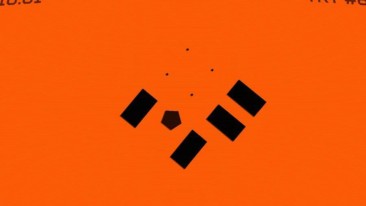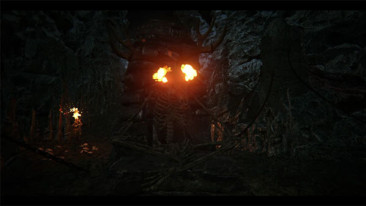Kerbal Space Program – What We Think:
Kerbal Space Program from Mexican City-based developer Squad is a physics-based space travel simulator. The tiny, frog-like Kerbals have grand ideas about etching out a place for their race in the stars, and it’s your job to help get them there.
The Kerbals began their trek into the starry expanse four-and-a-half years ago(!) when this game entered its alpha phase. While we could see a lot of promise, we had some concerns about the amount of parts available for constructing spacecraft. Is the finished product ready for launch?
With a fully fleshed out science quest mode, a deep well of ship parts from which to create space vessels, and a no-holds-barred sandbox mode, the Kerbal Universe has grown to cosmic proportions.
You Can’t Take the Sky from Me
For those who haven’t already experienced an earlier form of the now completed game, you need to create a craft worthy of escaping Kerbin’s gravity. Once this lofty goal is achieved and you can maintain a stable orbit, you can create lander craft that will allow you to touch down on Kerbin’s moon (Mun) and other planets in the solar system. Construct orbital space stations and dock your space planes with them as waypoints on lengthier flights. Be assured that none of it is as easy as it sounds. In fact, you will need to think like a rocket scientist.
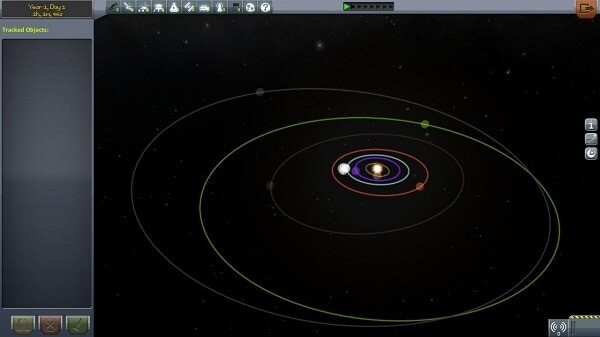
In Sandbox Mode, you have access to a full host of ship parts and a selection of pre-crafted ships. If you simply can’t be bothered with making the necessary scientific research milestones to unlock parts gradually, make this your approach vector. Though you won’t have access to anything other than the design facilities and launch pad, every craft item in the game is available, allowing you to immediately begin crafting powerful, gargantuan space vehicles.
Ah, but gravity is a cruel mistress. All the super-powered booster rockets in the world don’t mean squat if they are too heavy or fail to cut the resisting winds. To reach the stars, you’ll have to fine tune, and then fine tune some more.
I’m Gonna Have to Science The $#!* Out of This
Career Mode offers the most structured progression of all the modes. It drops players in the director’s chair of the Kerbal Space Program in its infancy. You start with a few beaten up parts, and others need to be unlocked by collecting enough science and allocating the resources to research. Completing various missions will net money, science, and reputation points.
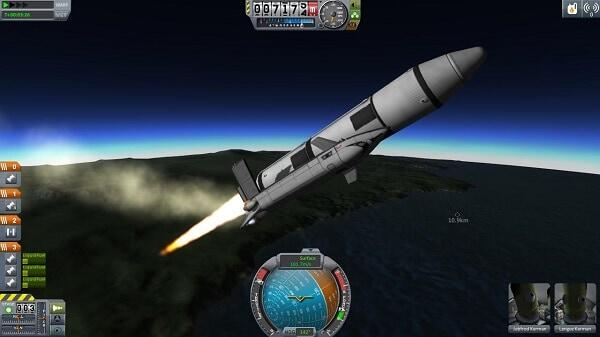
Science can be your best friend and your worst nightmare: Successfully getting a ship free of the planet’s gravity requires an extremely delicate balance of aerodynamics, all of which is affected by the design of your ship. If your vessel throws out too much drag, you can overheat and explode. If your attempts to make your ship atmosphere-worthy aren’t well placed, it might result in a perilous spin that can cost vital fuel.
This learning curve is lessened somewhat by taking on missions. Although some of the early tasks – testing ship parts in action or on the launch pad – can be really mundane, meeting the target criteria forces you to tweak the configurations of your craft. Each new ship part is essentially a wild card when introduced to your previously tried and true assemblies. In finding a way to get all your parts to play nice, you develop a deeper understanding of how all the parts function and co-relate. The points accumulated from more prestigious missions can also give you a real kick-start towards some of the more significant R&D discoveries.
Kerbal Stomp
For all the unrelenting precision of the physics, the experience is tempered greatly by the over-the-top cartoonish glee that emits from the Kerbals themselves. They never speak, only making the odd guttural grunt of approval. The faces of your pilots appear on the bottom right of the screen, constantly reacting to the status of the current flight. In a game that is so entrenched in the need for physical precision, the goofy antics of your crew are a welcome and endearing diversion.
In fact, my first few catastrophic crashes were gut-wrenching. I hated seeing my failures claim the lives of the adorable little Kerbal pilots (especially if it were due to an egregious oversight like forgetting to add a parachute to my control pod). But you’ll have to soldier on. They knew the risks when they signed up, and there’s a universe to chart.
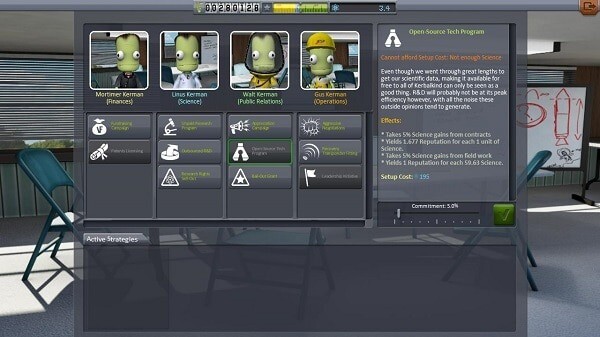
Too many catastrophic failures can land you a bad reputation, and this makes it more difficult to bring in decent Kerbal recruits. If a quick shot of PR juice is required, your admin team can launch a host of initiatives. Successful completion of missions can slowly drag your good name back out of the mud, but a well-funded appreciation campaign can turn things around quickly.
You can also sell off some of your scientific discoveries, and if you’re a little light in the wallet after having blown up more parts than you’ve recovered, you can even appeal for a government bailout.
My God, It’s Full of 5 Stars!
NASA didn’t have a hand to hold, and neither do you. Kerbal Space Program drops you in the middle of a mad dash for the stars, and trial and error are your two greatest assets. Gigantic explosions will frequently permeate your latest inspiration, claiming the lives of the brave Kerbals who had faith in your design. Even when you feel like packing it in, a quick glance up is all it takes to remind you that the heavens are still out there, calling you.
Kerbal Space Program successfully creates an experience that turns failures into teachable moments, and small successes into events worthy of hearty fist-pumps. And yet, your only real reward for reaching a checkpoint is a clearer view of the next checkpoint. An unrelenting course of instruction in physics and space travel sneakily becomes an endearing test of will that will keep you saying “one more launch”.
[xrr rating=”5/5″]
Kerbal Space Program is available through Steam
Check out IGR’s interview with developer Daniel Rosas at IndieCade 2015:




